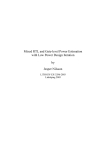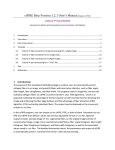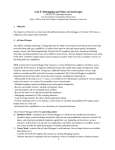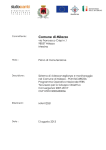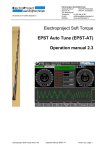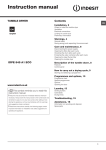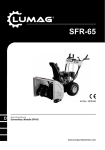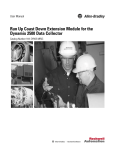Download The Time is Ripe for Paying Attention to Clothes Dryers
Transcript
THE TIME IS RIPE FOR PAYING ATTENTION TO CLOTHES DRYING TECHNOLOGY AND POLICY IN RELATION TO EFFICIENCY AND DRYING TIME Dave Denkenberger, PhD, Ecova; Chris Calwell, Ecova; David Thomsen, Ecova; Apurva Pawashe Independent contributor; Brian Spak, Independent contributor; Gary Fernstrom, Consultant to PG&E August 2014 ABSTRACT The time it takes for a clothes dryer to dry a load of laundry is important to consumers. On a heavy laundry day, many consumers expect the drying to be completed by the time the washing is done in order to quickly run one load after another. To assess the efficiency of dryer technologies with respect to drying time, we tested a variety of North American and European dryers. Further, we modified a conventional dryer to include exhaust air-to-air heat exchanger technology. We found various energy-efficient dryer technologies can have significant impacts on drying time. Unvented heat pump dryers, which can use 50 to 60 percent less energy compared to conventional electric dryers, take two to two-and-a-half times as long to dry. Another efficient dryer technology is an exhaust heat exchanger that uses waste heat coming out of the drum to preheat incoming air. This technology can reduce energy use by about 20 percent and actually reduces drying time. Another method of saving significant amounts of energy is running the dryer in no-heat mode much of the time, saving about 25 percent of energy use but tripling the drying time. Automatic termination saves approximately 15 percent of energy and decreases drying time. Natural gas dryers provide a cost-effective way of reducing environmental impact with fast drying, while vented heat pump and radiofrequency dryers represent promising emerging technologies. With increased network capability coming to the market, some of these energy saving options could be turned on or off through software upgrades. PAGE 2 | 2014 ECOVA INTRODUCTION Clothes dryers have become ubiquitous in US households with nearly 80 percent penetration. In total, dryers now represent a $9 billion annual national energy bill—about 6 percent of residential electricity consumption and 2 percent of residential natural gas consumption (Denkenberger 2012). They consume as much electricity per year—60 billion kWh—as the entire state of Massachusetts, and are responsible for 40 million metric tons of annual carbon dioxide emissions (Denkenberger 2012). The value proposition of a clothes dryer is essentially one of convenience – it was invented as quicker and easier alternative to line or rack drying. The consumer accepts the capital and energy costs of the dryer, as well as the additional wear-and-tear on their clothing, in exchange for this convenience. Therefore, the cycle time may be critical to many buyers. Research indicates that an 80-minute time requirement for a drying cycle would likely meet consumer needs and expectations for a load of laundry consisting of real clothes.1,2 Conventional electric resistance clothes dryers available in the US market today are capable of meeting consumers’ preferences for drying time; however, current high-efficiency clothes drying technologies often trade drying time for gains in efficiency. In this paper, we explore the technical improvements that can be made to clothes dryers to improve their energy efficiency, and discuss their corresponding implications to drying time. With this in mind, we argue that standards and voluntary labeling specifications should take into account drying time when setting efficiency requirements for different drying technologies. We begin by introducing technologies to improve dryers familiar in the U.S. that are electric resistance and vented. Most European dryers are electric resistance unvented, which means they recirculate the same air and condense the water out of it. Next, we speak to heat pump dryers - all commercially available models are unvented, but it is possible to have a vented heat pump dryer. Additionally, we discuss the efficacy of gas dryers. Lastly, we provide conclusions and next steps. 1 Consumer Reports evaluated clothes washers for a variety of factors, and our analysis of their data identified 80 minutes as the average cycle time (Consumer Reports 2013). 2 Many consumers prefer washer and dryer cycle times to match so they may easily launder sequential loads (Pescatore, 2005). PAGE 3 | 2014 ECOVA TECHNOLOGY IMPROVEMENTS FOR CONVENTIONAL DRYERS INSULATION IMPROVES EFFICIENCY BY 2 TO 6 PERCENT OVER CONVENTIONAL DRYERS Adding insulation between the drum and the dryer better retains heat in the dryer enclosure. Previous studies by the European Union Ecodesign for Energy Using Products initiative and by DOE estimate that insulation saves 3 percent to 6 percent (DOE 2010) over conventional dryers, respectively. Ecova’s laboratory tests of this concept show a 2 percent efficiency gain from adding ¾ inch thick expanded polystyrene foil-faced insulation with an insulation value of R-5. The foil acts as a radiant barrier, reducing heat transfer and preventing pieces of insulation from breaking off into the dryer enclosure. We fully insulated the top, back, and bottom of the cabinet with one layer of insulation. We found that the greatest heat loss was through the back of the cabinet because of the presence of the heater, so additional insulation on the back could achieve even greater cost effective savings than measured. The drum comes very close to the sidewalls, so we only insulated areas that did not inhibit drum rotation, about two-thirds of the total sidewall area. Similarly, we insulated some areas of the front wall where the insulation did not prevent the dryer from functioning. These improvements increased dryer efficiency by 2 percent without significantly impacting drying time. AIR-TO-AIR HEAT EXCHANGER IMPROVES EFFICIENCY BY UP TO 26 PERCENT A dryer equipped with an air-to-air heat exchanger reuses waste heat coming out of the drum to increase the temperature of incoming air. When warming incoming air, the hot air leaving the drum is cooled to a lower temperature in the heat exchanger, condensing water as it cools. The DOE Technical Support Document evaluated a condensing exhaust heat exchanger and projected 14 percent savings. (DOE 2010) Additionally a 1984 study by Lawrence Berkeley National Laboratory (LBNL) in which researchers modified and measured a dryer showed a 20-26 percent efficiency gain using a heat recovery ventilator as the heat exchanger (Heckmat 1984). They found that lint buildup over time reduces the heat exchanger’s effectiveness, however heat pump and condensing electric resistance manufacturers have dealt with that issue by using the condensed water to rinse the heat exchanger, or having the consumer remove the heat exchanger to clean it. To test this concept, we also used a heat recovery ventilator as PAGE 4 | 2014 ECOVA the heat exchanger. In Ecova preliminary laboratory measurements, the heat exchanger saved 17 percent and reduced drying time by 18 percent. 3 MODULATING HEATER POWER AND AIRFLOW IMPROVES EFFICIENCY BY 10 PERCENT Fast airflow and high temperatures generally reduce drying time, though high exhaust airflow provides little benefit when the dryer is first coming up to temperature and when the load is nearly finished drying. Some dryers offer a slower drying option, typically labeled “eco-mode” (see “Slow Drying” section). An eco-mode that does not sacrifice too much drying time would modulate both the heater thermal input and fan speed. Slower air movement allows more time for heat transfer and evaporation, still removing moisture from the clothing but not wasting as much heat to the exhaust air. Conventional vented dryers draw the intake air over the motor, which spins both the blower and the drum, to reclaim the motor heat. This means there is less of an incentive to increase motor efficiency. In order to implement the high energy savings modulation, a variable speed blower motor is required, which is inherently a more efficient type of motor than those typically used in dryers today. We estimate 10 percent energy savings are achievable by implementing modulation with a variable speed blower motor. A study by TIAX in 2005 measured efficiency improvements of up to 25 percent for small and medium load and 10 to 15 percent for large loads as a result of implement modulation (Pescatore, 2005). Drying time will be slightly slower with modulation. We tested a compact 120 V dryer that utilizes low airflow and is commercially available today. The exhaust temperature was significantly lower, and relative humidity much higher than conventional dryers, indicating less heat waste. In preliminary testing, the drying process was ~10 percent more efficient than conventional dryers, though the drying time was longer. 4 OTHER DESIGN OPTIONS NOT TESTED A design could partially re-circulate exhaust air that is still quite dry, which would reduce the need for heater power to achieve a given air temperature and/or potentially shorten drying time. Also, improvedefficiency blower blades (which are backward curved) would reduce energy losses associated with delivering a given amount of airflow. 3 This did increase the drum inlet temperature. If this is not acceptable, the heater could be made smaller, actually saving costs, and having the same drying time as the unmodified dryer. 4 The overall CEF showed a smaller improvement because the standby power of compact dryers relative to the energy used to dry clothing is larger than for conventional dryers. This standby power can be reduced by techniques explained in the DOE technical support document. PAGE 5 | 2014 ECOVA One obvious way to improve conventional dryers is for manufacturers to improve their automatic termination to reduce the energy and time wasted while heating and tumbling clothing which is already sufficiently dry. We did not modify this hardware or software, but note that DOE’s measurements and our own measurements confirm energy efficiency differences of approximately 17 percent between conventional electric resistance models that terminate well and those that terminate poorly. The best designs also reduce average drying time by about 5 minutes. SLOW DRYING We tested several dryers on delicate or low-temperature mode. Figure 1 shows the cumulative energy of low-temperature versus high-temperature behavior of a conventional dryer. The steepest slope occurs when the heater is full on, the intermediate slope is the heater half on, and the low slope is the heater off (the only power draw is the motor spinning the drum and the fan). On average across five conventional electric dryer models, this lengthened drying time by 23 percent and increased efficiency by 3 percent (see Figure 1). Because the results of the tests performed in low-temperature mode (also referred to as “Delicates Mode”) resulted in modest changes to efficiency, we took one high-end dryer and one entry-level dryer and modified how they behaved. We switched the mode to no heat periodically to maintain a low exhaust temperature. The “Conv Dryer Modified Software Run” in Figure 1 shows a typical power over time profile of this behavior. Across two conventional electric dryer models, this lengthened drying time by 141 percent and increased efficiency by 30 percent (see Figure 1). 3.0 Cumulative kWh 2.5 2.0 1.5 1.0 Conv Dryer High Temp Run 0.5 Conv Dryer Delicates Mode Run 0.0 0 10 20 30 40 50 Time (minutes) 60 70 80 Figure 1: Cumulative energy consumption over time for full size conventional dryer across different drying modes (CA IOU 2013b). PAGE 6 | 2014 ECOVA Interspersing the no-heat mode lengthened the drying times significantly, but allowed both dryers to be 5 above the EPA-proposed 3.93 CEF . Manufacturers could make this behavior the default mode that the DOE test procedure specifies. Many, if not most, consumers may find such factor of 2-3 drying time extensions to be unacceptably long and will instead choose a faster mode. 5 CEF, or Combined Energy Factor, measured in pounds of clothing dried per kWh is the primary metric used to measure the efficiency of a clothes dryer. PAGE 7 | 2014 ECOVA RECOMMENDED SPECIFICATION/STANDARDS FOR CONVENTIONAL DRYERS PROPOSED TIER 1 CEF SPECIFICATION/STANDARD LINE FOR VENTED FULL SIZE ELECTRIC DRYERS We have been engaged in making recommendations to the ENERGY STAR process (CA IOU 2013a, 2013b, 2014). What follows represents an update to this thinking that could be used for future specifications and mandatory standards. We have constructed a potential specification/standard that links efficiency criteria to drying time, demonstrated in Figure 2. In order to construct our proposal, we first found the best-fit CEF line with conventional dryers (orange dotted line on Figure 2). We ran one high-end 6 dryer in no-heat mode to test the extreme case. With no heat, the dryer relies on the natural desiccating capability of the room air. With the energy used to spin the fan and drum, drying occurs at about twice the efficiency of a conventional dryer in heat mode, but it takes about five times as long. This also explains the above findings: slowing the drying down by running a significant fraction of the time in no-heat mode increases the efficiency. 6 We were not able to find a dryer that automatically terminated on no-heat mode. Therefore, we had to do multiple timed dry segments with intermediate weighing to achieve this result. The efficiency would likely be even greater without these intermediate weighings. PAGE 8 | 2014 ECOVA 7.5 80 minutes z Combined Energy Factor (CEF) 6.5 5.5 ENERGY STAR Final Draft Version 1.0: CEF = 3.93 ENERGY STAR Database 4.5 CA IOU Baseline CA IOU Delicate Settings Samsung ETA Dryer 3.5 CA IOU Conv Dryer No Heat Time Dry Test CA IOU Conv Dryer Modified Software 2.5 0 50 100 150 200 250 Duration (minutes) Figure 2: Tier 1 California Investor-Owned Utility (CA IOU) proposed specification for conventional residential clothes dryers (CA IOU 2013b). The green line in Figure 2 represents a proposed specification/standard line that increases efficiency stringency (CEF) with drying time. The orange dotted line represents a baseline for vented full size electric dryers that is based on drying time and CEF data represented in ENERGY STAR’s analysis, as 7 well as new data that we collected. The blue lines represents EPA’s ENERGY STAR Final Draft Version 1.0 specification plus supplement for vented full size electric clothes dryers (CEF = 3.93 and <80 minutes). For our proposal, we took this baseline curve fit and multiplied both the intercept and coefficient 8 to the drying time by 1.25, representing 20 percent energy savings (see Figure 2). Note that the Samsung 2013 Emerging Technology Award winning dryer is on the trend line for conventional dryers slowed down, and would not qualify for ENERGY STAR as proposed or our sloping line proposal. Improved motor, more efficient blower blades, and lower pressure drop ducting inside the dryer benefit even to the no-heat case. Our proposed criteria does not to give additional energy use allowance for even faster drying time than typical dryers (the horizontal section of the green line in Figure 2). To ensure that energy savings promised by a specification or standard are preserved in day-to-day operation, it is 7 This baseline does not include the advanced technologies of heat pump and exhaust heat exchanger. 20 percent energy savings corresponds to 0.8 times as much energy use. The reciprocal is 1.25 times as efficient, or 25 percent greater efficiency. 8 PAGE 9 | 2014 ECOVA essential to test each dryer on multiple modes. We recommend testing the dryers in fast, medium, and slow modes, as defined below (see shaded regions in Figure 2). Three test repetitions at each of these 9 modes would require a total of nine test runs. This is not overly burdensome on manufacturers relative to the value of the resulting energy savings; indeed it is the same number of tests DOE and ENERGY STAR already require for clothes washers, where efficient models yield smaller lifetime energy savings than clothes dryers relative to less efficient models. Slow mode: the user manual should indicate the slow test settings. This could be an eco-mode or the lowest available temperature that performs automatic termination. The CEF must be greater than or equal to 5.0 and on or above the specification line (see yellow and green shaded regions in Figure 2); Medium mode: use the DOE appendix D2 test procedure. The CEF must be greater than or equal to 4.0 and on or above the specification line, and less than 80 minutes (see blue and green shaded regions in Figure 2.); Fast mode: the program selected should be the one indicated in the manual which dries the clothing most quickly. Also, the technician should disable any energy-saving features. The CEF must be greater than or equal to 4.0, on or above the specification line, and less than 80 minutes. If there is no faster mode than that specified by appendix D2, the fast test would not have to be performed (see blue and green shaded regions in Figure 2.). PROPOSED TIER 2 CEF SPECIFICATION/STANDARD LINE FOR VENTED FULL SIZE ELECTRIC DRYERS Our testing, as well as that conducted and published by DOE, confirm that improved automatic termination alone offers energy savings of roughly 17 percent and can trim approximately five minutes off typical automatic termination cycle times. We illustrate the effect of this improvement on Figure 3, below, highlighting the differences in energy efficiency and drying time among the range of conventional electric resistance models we have recently tested in the laboratory with the D2 test procedure. Some manufacturers may simply elect to slow down the drying process in the default mode, by either lowering the heating element wattage or decreasing the fraction of time that the heating element is on. If dryers with improved automatic termination typically complete a D2 cycle in approximately 40-45 minutes this gives them roughly 35-40 additional minutes of time to slow the drying process down, gaining approximately 0.16 lbs/kWh for every 10 additional minutes the drying process requires. Therefore, at 80 minutes, these well-automatically terminating dryers would have a CEF of ~4.5. Indeed, we have shown that an entry-level (approximately $300) dryer with only simple changes to the operation of the dryer’s 9 Alternate testing requirements could be proposed, including using more realistic clothing and varying load sizes (see Dymond 2014, this conference). PAGE 10 | 2014 ECOVA heater can achieve a CEF of 4.36 and a drying time of 60 minutes. Basic dryers already monitor exhaust temperature to prevent clothing damage, so including this temperature switching would only require an inexpensive and simple software change. 10 Figure 3 demonstrates the tradeoff between efficiency and drying time for individual dryer units tested in Ecova’s lab using the D2 test procedure. 11,12 Square markers represent D2 tests (lowest efficiency data points in each trend). The higher efficiency data points for each dryer represent either delicate, eco-mode, or manual override tests. Circular markers represent tests conducted in these higher efficiency modes. In cases where only D2 and delicate runs are available, we have extrapolated the behavior with dotted lines. Figure 3 illustrates how dryers with poor automatic termination are generally not able to meet the EPA proposed ENERGY STAR specification line simply by extending their cycle time, from what had been roughly 40 minutes to a value closer to the 80-minute cutoff. It also illustrates how dryers with good automatic termination can meet the IOU proposed ENERGY STAR specification line either by improving the underlying technology of the dryer (Step 2A) or by extending their cycle time (Step 2B). The specification/standard line that represents combining the technologies of exhaust heat exchanger, etc with optionally slowing the dryer down is shown in green. We recommend this as a Tier 2 for non-heat pump dryers. We note that the May 2014 Emerging Technology Award proposal, which is supposed to require heat pump dryers, is similar to our Tier 2 proposal for non-heat-pump dryers. 10 The relay that switches the heater on and off would have to endure more cycles, so it would have to be more durable. 11 Each colored square in the charts above represent a unique dryer unit sometimes tested in multiple settings not explicitly stated in the DOE D2 test procedure. Tests for which we measured the energy use of these dryer units in different settings were conducted for the purposes of assessing the relationship between efficiency and drying time. 12 The CEF values for dryer units represented in the charts below were not adjusted for EPA's proposed 5 percent CEF allowance for connected functionality, which would have the effect of either raising the measured efficiency of those models or reducing the efficiency target they need to meet by 5 percent. PAGE 11 | 2014 ECOVA 4.8 80 minutes 4.6 Step 2A: Better Technology Combined Energy Factor (CEF) 4.4 CA IOU Draft 2 ENERGY STAR Proposal CEF = 4.29 4.2 4.0 ENERGY STAR Final Draft Version 1.0: CEF = 3.93 3.8 3.6 3.4 Step 1: Improve Automatic Termination Design 3.2 3.0 30 40 50 60 70 80 Duration (minutes) 90 100 110 Figure 3. Potential design improvement options required to achieve efficiency gains (AT is automatic termination) (modified from CA IOU 2014). PAGE 12 | 2014 ECOVA 120 IMPROVING HEAT PUMP DRYER TECHNOLOGY Even with condensing dryers, heat pump dryers open up the possibility of significantly different behavior with different drying time. For instance, a hybrid heat pump contains electric resistance elements that can be turned on for faster drying, though this makes the efficiency lower. Another route is a heat pump with a variable compressor speed. The higher compressor speed would produce higher air temperatures and/or more heat and thus faster drying, but lower efficiency. Therefore, a heat pump specification/standard should increase with drying time and multiple modes should be tested. We first analyzed unvented heat pump dryers, because these are the only ones commercially available anywhere in the world. We used the four heat pump dryer tests performed for The Collaborative Labeling and Appliance Standards Project (CLASP) (see Figure 4) (Wold 2013). Then we added recent testing of a hybrid heat pump dryer and a variable speed heat pump dryer. The best-fit line (indicated by the solid green line in Figure 4) for the dryers that can actually be sped up shows a significant efficiency penalty associated with speeding up the drying time. Following this trend line, an 80 minute drying time dryer would be less efficient than a conventional dryer! Therefore, there is potential to do much better. Combined Energy Factor (CEF) 9.5 9.0 Ventless Heat Pump Dryers 8.5 Ventless Hybrid Heat Pump Dryers 8.0 Calculated Vented Heat Pump Dryer 7.5 7.0 6.5 6.0 5.5 5.0 30 45 60 75 90 105 120 Cycle time (minutes) Figure 4: Heat pump dryer data and estimate for vented heat pump dryer technologies (original research). PAGE 13 | 2014 ECOVA One way of improving an unvented heat pump dryer is to vent it. TIAX found that this resulted in higher efficiency and shortened drying times (Pescatore 2005). Unfortunately, we do not have comparable data to plot with the new test procedure. We estimate the impact of venting as a 10 percent increase in efficiency and 10 percent decrease in drying time, roughly based on conventional vented and unvented dryers. One way of implementing a vented heat pump dryer is still having the heat pump remove heat from the drum exhaust, but not removing all of the heat. The remaining heat and moisture would be vented and therefore the dryer would no longer reject significant heat into the room. For even faster drying with electric resistance boost, the efficiency of a vented heat pump dryer would be higher than that of conventional dryers because some of the heat is coming from the heat pump. The dotted line in Figure 4 shows our efficiency-time trend estimate for a vented hybrid heat pump dryer. It is uncertain whether unvented heat pumps would be as cost effective as some other technology options in the near term. However, we believe that incorporating an air-to-air heat exchanger in heat pump dryers could lower cost, increase efficiency, and reduce drying time. Given the high absolute energy savings potential offered by heat pump dryers today, a more stringent specification might be justified for a program such as Top Ten or EPA’s Emerging Technology Award, or EPA’s Most Efficient specification. We conducted testing to determine whether certain compact dryer models (under 4.4 cubic feet drum volume) we had previously tested with a standard load would pass the EPA proposed efficiency levels and the 80-minute requirement when tested with a compact load, as required under the DOE test procedure. Our testing found that all of the European compact unvented clothes dryers we tested meet both the efficiency level and time requirement when tested using DOE’s compact 3-pound load in at least one mode, and often in all modes tested. We found that reducing load size from 8.45 to 3 pounds, tended, on average to reduce drying time by 33 percent and reduce efficiency by 42 percent. PAGE 14 | 2014 ECOVA OTHER DRYER TECHNOLOGIES 13 There is a radio frequency (similar to microwave, but at much longer wavelengths) dryer prototype . This prototype only tumbles the clothing 5 percent as much as a regular dryer, dramatically reducing clothing wear-and-tear. Furthermore, the temperatures required to remove the water quickly are lower, further reducing clothing wear-and-tear. Third-party validation is required, but preliminary tests indicate significant energy savings and low drying time. The cost may be competitive with heat pump dryers. For the vented compact 120 V and 240 V dryers, no-heat mode would offer high efficiency. Therefore, the specification/standard should be a function of drying time. Also, testing in multiple modes would guarantee that consumers will enjoy energy savings regardless of drying speed. We do not yet have data to make specific recommendations. Unvented dryers are inherently less efficient than vented dryers (all else being equal, like the heat source) because unvented dryers cannot utilize the natural desiccating properties of room air. This also tends to increase drying time. Furthermore, though some efficiency is gained by slowing the drying process down, it would not be nearly as dramatic as the case of no heat for vented dryer. Therefore, it is not imperative to have a specification or standard line for unvented that varies with drying time. We do not have additional data for these categories. With the lower sensitivity of efficiency to drying time, it would be less important to test the unvented dryers on multiple modes. 13 CoolDry Radiofrequency Dryer: http://cooldryrf.com/technology PAGE 15 | 2014 ECOVA OTHER CONSIDERATIONS GAS DRYERS AND SOURCE ENERGY Slowing gas drying reduces the site energy consumption similarly to slowing electric drying. However, on a source energy basis, there is little advantage to slowing gas drying. Therefore, it probably does not make sense to have a standard or specification be a function of drying time. For the same reason, it is less important to test gas dryers on multiple modes. Figure 5 shows an apples-to-apples comparison with conventional electric and heat pump dryers. The electric source energy multiplier to CEF is 0.26 and the gas source energy multiplier to CEF is 0.71, the US averages taking into account extraction, conversion, and transportation. A heat pump dryer can use less source energy than a gas dryer. However, with competitive drying time provided by the electric resistance boost, the heat pump would likely no longer lower source energy than a gas dryer (not shown) unless a particular home or region’s generation mix has a far greater renewables share than the national average. There is likely more room for improvement with gas dryers than with heat pump dryers. Even if there were a scenario where the emissions of a heat pump were lower than gas, the greater cost of the heat pump would make the cost of emissions saved comparatively high. PAGE 16 | 2014 ECOVA 2.5 Combined Source Energy Factor (lbs/kWh) 2.3 2.1 1.9 Heat Pump Dryers Gas Dryers 1.7 1.5 1.3 1.1 Conventional Electric Resistance Dryers - Slowed Down 0.9 0.7 Conventional Electric Resistance Dryers 0.5 30 60 90 Cycle time (minutes) 120 Figure 5: Source energy of gas, heat pump, and conventional dryers (original research). It is possible to construct a natural gas heat pump dryer. The concept is to burn the natural gas and drive an absorption cycle that would produce more heat to dry the clothing than from burning the natural gas alone. Even if this is not economical due to relatively low natural gas prices, all the technologies listed above for conventional electric dryers could apply to natural gas dryers (except for air recirculation). Some of them would be less cost-effective because of the lower cost of the heat. Furthermore, it would not be prudent to make a gas specification or standard level too stringent, because this would increase the upfront cost, discouraging switching to low-greenhouse-gas emitting natural gas. There is concern that future high natural gas prices would make natural gas dryers uneconomic. Therefore, we have graphed the lifecycle costs (LCC) of a number of dryer options with different energy costs (the base dryer cost is $300). The gas dryers have two scenarios of the laundry room being plumbed for gas and the gas line needing to be extended from another gas appliance in the household (with an extra $300 cost). The low electricity price starts at $0.05 per kWh and the high at $0.16 per kWh. Then as the price of natural gas increases (historic numbers are adjusted for inflation), the price of electricity increases slightly due to the use of natural gas in electricity production. The fast heat pump has electric resistance boost to have competitive drying time with electric resistance dryers, with an PAGE 17 | 2014 ECOVA incremental cost of $300. We assume that the fast heat pump is used in slow mode (heat pump only) half of the time. This corresponds roughly to the fraction of last loads of the day, where there is no new load coming from the washer, so time is less critical. The improved electric resistance corresponds to the Tier 2 of conventional dryers. We assume that the incremental cost is $100 and it is also used in slow mode half of the time. We use baseline energy use from the NEEA field study (NEEA 2012). One can see that even with low electricity price, using a gas dryer when the laundry room is already plumbed is competitive with the heat pump and improved electric resistance dryers for reasonable gas prices. Furthermore, even when the natural gas line needs to be extended within the household, this is lower cost than the electric options for high electricity price (and indeed most of the country with realistic gas prices). $2,500 $2,300 2008 (max) 1990s Pre-energy Elec high cost LCC Dryer life cycle cost ($) $2,100 current $1,900 Fast HP high cost LCC Improved elec high cost LCC Gas with line extension LCC Elec low cost LCC $1,700 $1,500 $1,300 Fast HP low cost LCC Improved elec low cost LCC Gas LCC $1,100 $900 $700 $500 0.5 1 1.5 2 Residential gas price ($/therm) Figure 6. LCC of different dryer technologies with different energy prices (original research). Even if it turns out there is not nearly as much natural gas as is widely believed today, the natural gas price has a natural control at least over the next few decades. This is because it is more economical to switch gas water heating and space heating to electricity than it is to switch gas dryers to electricity. One reason for this is that no heat exchanger is required for a natural gas dryer, because the combustion gases go directly into the drum. Another reason is that the temperature lift required by the heat pump to maintain performance is greater for dryers than for hot water heaters or space heaters. Finally, there are generally economies of scale associated with heat pumps, and at least space heaters require larger compressors than dryers. Therefore, if natural gas prices get very high, the demand for natural gas from space and water heating will fall, controlling the natural gas price. PAGE 18 | 2014 ECOVA There is a significant cost, carbon, and other emissions savings opportunity associated with encouraging the use of natural gas dryers. Given permission and oversight from their regulators, utility programs could subsidize the extension of the natural gas line to the laundry room (in new and existing construction) and the purchase of natural gas dryers, and deliver cost effective societal benefits as a result. PAGE 19 | 2014 ECOVA CONSUMER INFORMATION The DOE standard allows the use of the D1 test procedure (which does not test automatic termination) or the D2 test procedure (which does test automatic termination). This means that the DOE database has the potential to confuse consumers. We believe it would be useful to consumers if EPA were to report the annual and lifetime energy costs of each dryer model on the EPA website (this would be only D2 data). To help consumers understand the most energy efficient settings on their dryer, manufacturers should clearly and consistently label their efficient drying cycles in a way that maximizes the likelihood that consumers will use them. Increasingly, we have begun to see dryers that advertise efficient modes, often with an “eco” or “eDry” button. Some of the newest dryers even offer an “eMonitor” that show users the relative efficiency of all loads and settings. The benefits of properly designed automatic termination likely justify its mandatory inclusion in future standards. For the remaining dryers that have automatic termination capability, manufacturers should use an unequal choice hierarchy that will encourage user selection of the automatic termination option rather than timed cycles. PAGE 20 | 2014 ECOVA AREAS FOR FUTURE STUDY AND CONSIDERATIONS There are three areas primary where additional work is needed: Clothing wear-and-tear, indoor air quality and HVAC impacts, which are each significant issues associated with clothes dryers in addition to energy use and drying time. The clothing temperature associated with a longer drying time is lower, reducing clothing wear-and-tear. However, more tumbling of the clothing would increase clothing wear-and-tear. Therefore, the result is ambiguous at this point, but further study is warranted because the clothing wear-and-tear would likely be a greater cost than the energy use. As long as excessive building depressurization is avoided, exhaust ventilation provides significant indoor air quality benefits (ASHRAE 2010). These ventilation benefits could be even larger than the energy cost (Fisk 1999) especially for slow dryers. The impact vented dryers have on HVAC energy use is associated with conditioning (heating, cooling, and/or dehumidifying) the makeup air. This generally increases HVAC energy use. If a longer drying time is implemented with the same airflow rate, much more total airflow occurs, making the HVAC issue more important to study. We recommend that regulators take the near term step in this process of requiring the measurement of the airflow for the cycle. For unvented dryers (electric resistance or heat pump), all of the electricity going into the appliance is turned into heat that is then added to the room. 14 This is beneficial in the heating season, and detrimental in the cooling season, with this impact generally positive in the U.S. However, the net HVAC energy savings from unvented dryers would need to be weighed against the likely health benefits of greater venting in many homes. 14 Assuming there are no leaks, and not dryers that condense onto cold water (which EPA has rightly excluded from consideration of the ENERGY STAR label because of the large water use). Heat in condensed water is negligible. PAGE 21 | 2014 ECOVA CONCLUSIONS There is generally a trade-off between efficiency and drying time, but not always. Near-term cost-effective technologies can save 20 to 30 percent of energy with competitive drying times. It is important for consumers to have the option of drying slower and saving more energy. Specifications and standards should be designed to save energy at all speeds (e.g. a sloped specification line). Hybridized vented heat pump with air-to-air heat exchanger could provide additional savings. Natural gas dryers offer compelling consumer and environmental advantages, and should be encouraged. ACKNOWLEDGEMENTS We are grateful for the financial support of Pacific Gas & Electric (primary) and The Northwest Energy Efficiency Alliance (secondary). PAGE 22 | 2014 ECOVA REFERENCES 62.2 User’s Manual: ANSI/ASHRAE Standard 62.2-2010 Ventilation and Acceptable Indoor Air Quality in Low-Rise Residential Buildings,” December 13, 2010. California investor owned utilities (CA IOUs) 2013a. “ENERGY STAR® Clothes Dryers Draft 1 Version 1.0 Specification Comment Letter.” California investor owned utilities (CA IOUs) 2013b. “ENERGY STAR® Clothes Dryers Draft 2 Version 1.0 Specification Comment Letter.” California investor owned utilities (CA IOUs) 2014. “ENERGY STAR® Clothes Dryers Supplemental Proposal Comment Letter.” Consumer Reports. 2013. Recommended Clothes Dryers http://www.consumerreports.org/cro/clothes-dryers.htm Denkenberger, D, S. Mau, C. Calwell, E. Wanless, and B. Trimboli. 2012. “What Lurks Beneath: Energy Savings Opportunities from Better Testing and Technologies in Residential Clothes Dryers.” Proceedings of the American Council for an Energy-Efficient Economy: Summer Study. U.S. Department of Energy (DOE) - Technical Support Document for Residential Dryers, EERE-2007-BTSTD-0010, 2010. Fisk, W. 1999. “Estimates of Potential Nationwide Productivity and Health Benefits from Better Indoor Environments: An Update.” Published as Chapter 4 in Indoor Air Quality Handbook, eds: J. D. Spengler, J.M. Samet, and J.F McCarthy, McGraw Hill. Hekmat, D. & W.J. Fisk. 1984. Improving the Energy Performance of Residential Clothes Dryers, Presented at the 25th Annual International Appliance Technical Conference, Ohio State University, May 15-16. Northwest Energy Efficiency Alliance (NEEA). 2012. Regional Laundry Energy Use Study. http://neea.org/docs/rbsa/laundry_faq_2012-01-23-d.pdf?sfvrsn=0 Pescatore, & Phil Carbone. 2005. High Efficiency High Performance Clothes Dryer: Final Report to Department of Energy. TIAX. Wold, Christopher, Dave Denkenberger, Chris Granda, & Chris Calwell. 2013 Analysis of PotentialEnergy Savings from Heat Pump Clothes Dryers in North America. Technical Report, Super Efficient Clothes Dryer Initiative. PAGE 23 | 2014 ECOVA ABOUT ECOVA Ecova is the total energy and sustainability management company whose sole purpose is to see more, save more, and sustain more for its clients. Using insights based on consumption, cost and carbon footprint data spanning thousands of utilities, hundreds of thousands of business sites and millions of households, Ecova provides fully managed, technology-optimized solutions for saving resources, which in turn increase returns, lower risks, and enhance reputations. Ecova is a subsidiary of Cofely, the leading brand of GDF SUEZ Energy Services. For more information, visit the company’s website at ecova.com, on LinkedIn at linkd.in/ecovainc, or follow Ecova on Twitter at @ecovainc. CONTACT US Find out how we can put these solutions to work for you. 800 791 7564 @ecovainc facebook.com/ecovainc [email protected] linkd.in/ecovainc youtube.com/ecovainc ecova.com/insider ecova.com PAGE 24 | 2014 ECOVA © Ecova, Inc. All rights reserved.
























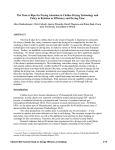

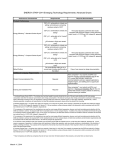

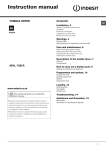

![RUMD User Manual [Version 3.0]](http://vs1.manualzilla.com/store/data/005734566_1-539a984f38202face31c4a646ef91457-150x150.png)
